Mammals of the Adirondacks:
Snowshoe Hare (Lepus americanus)

The Snowshoe Hare (Lepus americanus) is a species of hare found in conifer and mixed woods forests in the Adirondacks. It is an important food source for several Adirondack predators including Eastern Coyotes, American Martens, Gray Foxes, Red Foxes, and Fishers.
Snowshoe Hares are members of the Lagomorpha Order. Lagomorphs evolved over 50 million years ago in Asia, probably in grasslands. Many of their physical characteristics, such as their wide-set eyes, erect heads, and large ears, reflect features that were developed to detect and evade predators in open areas.
- Snowshoe Hares are part of the family Leporidae, which also includes rabbits, including the Eastern Cottontail (Slyvilagus floridanus). Eastern Cottontails are found mainly outside the Adirondack Park Blue Line, but may be seen occasionally in the southern and eastern lowland areas of the Park.
- Snowshoe Hares are assigned to the genus Lepus, which also includes jackrabbits and several other hare species. There are fifteen subspecies of Snowshoe Hare. Ours is Lepus americanus virginianus.
The Snowshoe Hare derives its nonscientific name from its large hind feet. These feet have long, dense hairs covering the soles, enabling the hare to travel on top of a layer of snow, much as snowshoes aid humans. Another name for this species – the Varying Hare – is a reference to the fact that the color of its coat changes from brown in the warmer months to white in winter, to maximize camouflage.
Snowshoe Hare: Description
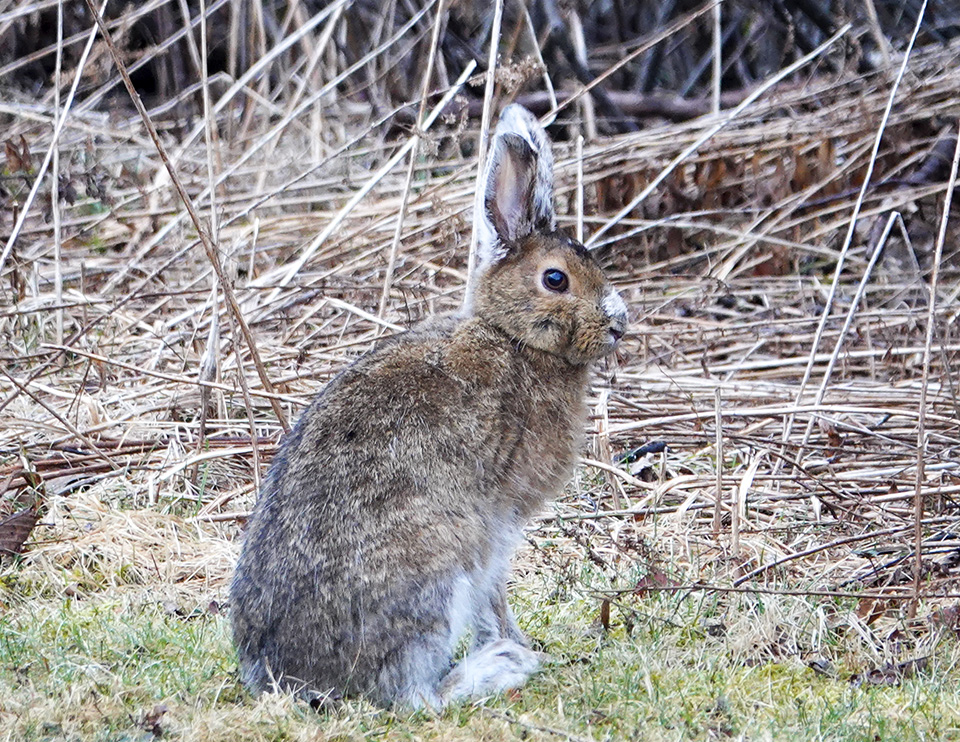
In terms of size, Snowshoe Hares are smallish mammals, weighing between three and 4½ pounds. Total length is about 20 inches. Female Snowshoe Hares weigh about 10-25% more than males.
The Snowshoe Hare's weight varies by region. Hares in the southwestern US are smaller than those in the northwestern and eastern regions of the country, where winter temperatures are lower. The larger body size of hares that live in colder regions may help them deal with the low temperatures and higher variability in food resources.
Snowshoe Hares have very large hind feet – an adaptation that facilitates travel in the snow. This feature is an important part of the hare's survival strategy because it gives the animal an edge over larger predators pursuing it in deep snow. In addition, by allowing the hare to travel on top of the snow, it has a chance to forage on higher layers of branches and twigs with each successive snowfall.
The Snowshoe Hare, like other lagomorphs, has elongated ears (enabling them to detect predators). In addition, their wideset, bulging eyes give them a wide range of vision to monitor their surroundings for predators.
Another part of the Snowshoe Hare's survival strategy is a seasonal color change to maximize camouflage. The change occurs twice a year: in the spring and again in the fall. In summer, the Snowshoe Hare's coat (pelagePelage: The fur, hair, or wool of a mammal.) is yellowish to cinnamon brown, with white to grayish-white chin, tail, and lower parts. The ears are tipped with black. Some individuals have a small white blaze on the forehead. The winter coat, which is worn from about mid-December until late April, is mainly white, with black rimming the ears.
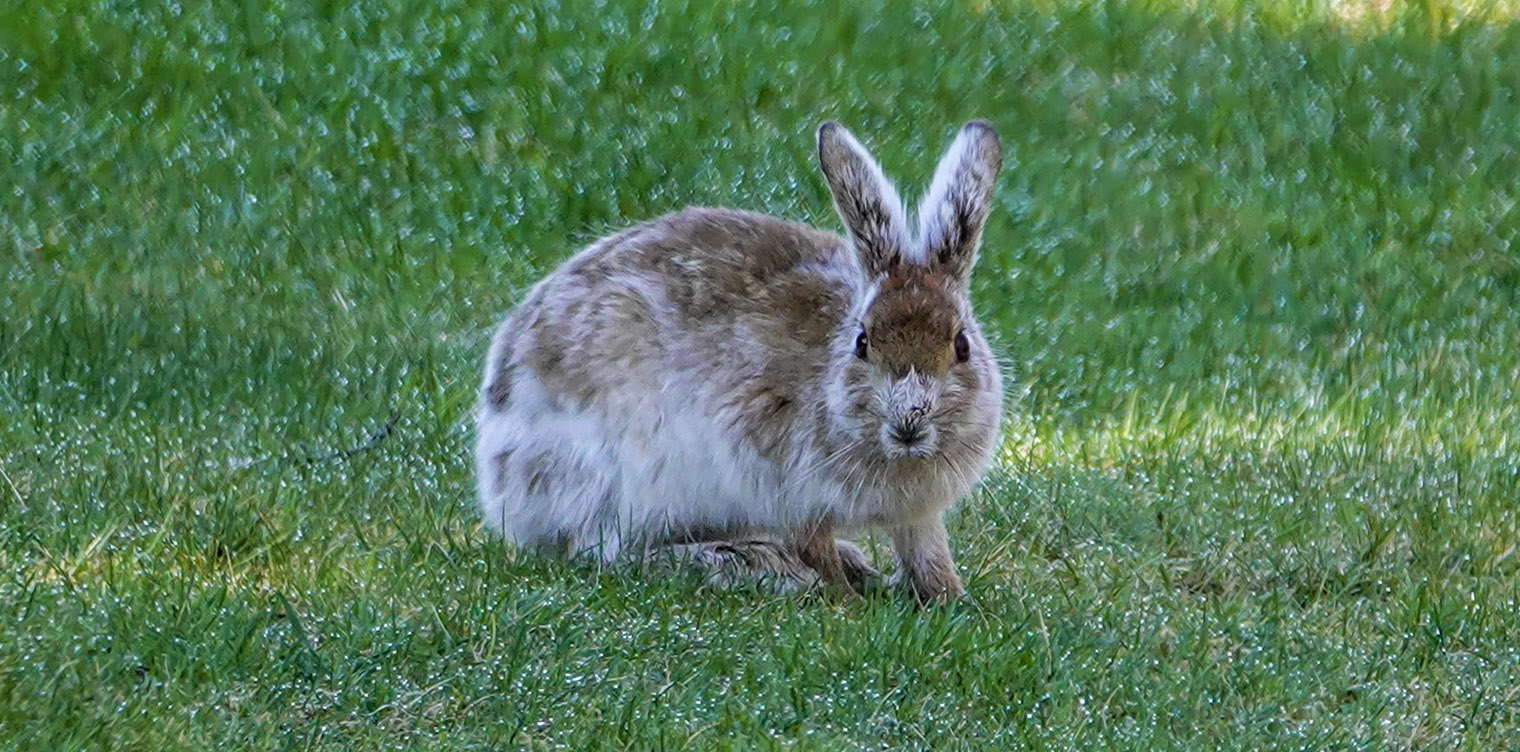
The seasonal color change takes place over a period of about 70 to 90 days. Females tend to molt more rapidly than males.
- The spring molt begins in March or April. The face, forehead, and nose change first. In the next phase, the body becomes mottled brown and white. The mottling spreads over the rump, hips, and shoulders; and the head appears brown except for the ears and patches of white on the cheeks. Eventually, the entire animal becomes mostly brown, with only the belly and lower abdomen retaining white.
- The autumn molt begins in late September. The color change starts on the ears, feet, and legs, ending on the back. At the end of the autumn molt, the animal appears almost completely white.
Molting is controlled by seasonal changes in the length of day, rather than temperature. This means that the Snowshoe Hare's camouflage system becomes out of sync in those years when winter snows or spring thaws come earlier or later than normal. As discussed below, this problem has major implications for the Snowshoe Hare's ability to adapt to climate change.
Snowshoe Hare: Diet
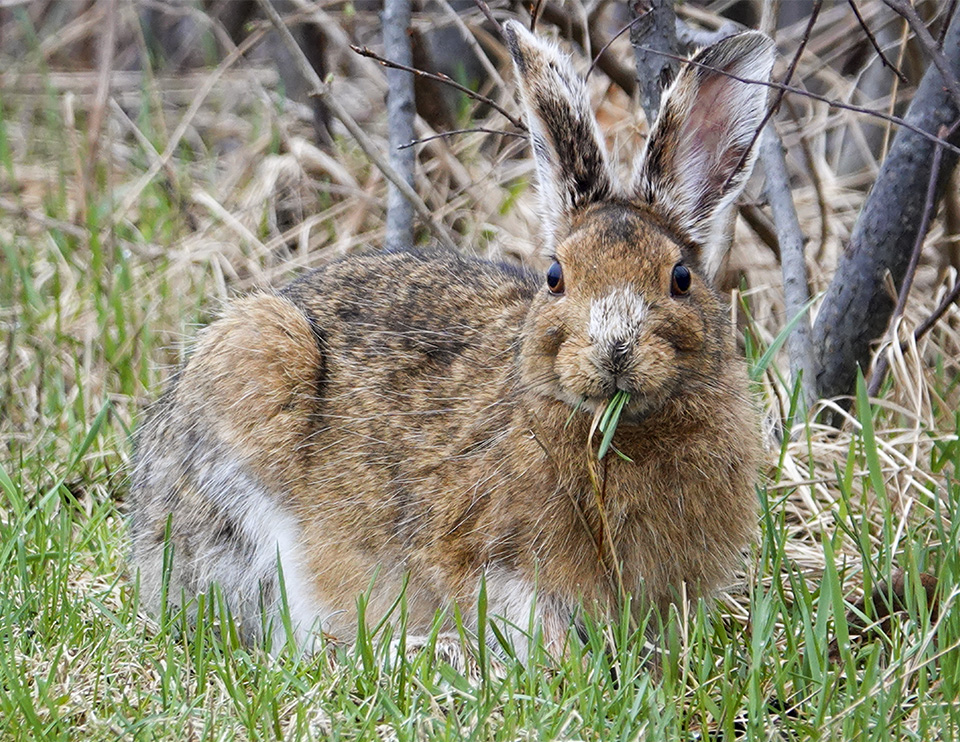
Snowshoe Hares are herbivores. A Snowshoe Hare requires 10.6 ounces of browse per day. Like other herbivores who live in areas with severe winters, their summer and winter diets are very different.
- The Snowshoe Hare's main summer food consists of herbaceous plants, such as clovers, grasses, sedges, and ferns. They also consume berries and the twigs and foliage of woody deciduous plants.
- In the winter, when green vegetation is no longer available, the hares switch to buds, twigs, evergreen needles, and bark. They prefer smaller twigs and stems (⅛ inch in diameter), but will eat larger stems in winter when necessary.
The list of plant materials on the Snowshoe Hare's menu is very long. In northern New York, it includes aspens, Striped Maple, Red Maple, Sugar Maple, Eastern White Pine, Red Pine, Paper Birch, Yellow Birch, Northern White Cedar, Eastern Hemlock, and Balsam Fir. Snowshoe Hares also feed on the bark of Tamarack, the twigs and bark of Leatherleaf, the fruit of Northern Wild Raisin, and the fruit, bark, and twigs of Serviceberry. Herbaceous plants on the Snowshoe menu include Canada Mayflower, Pitcher Plant, Fireweed, Dandelion, impatiens species, and Pussytoes.
Snowshoe Hares maximize the nutrition they gain from their food by producing two kinds of fecal materials: soft droppings and hard pellets. The soft droppings are reingested to recapture nutrients, especially vitamin B12. After passing through the digestive system a second time, the residue is expelled in the form of hard pellets, which are not eaten. This process is called refection.
Snowshoe Hare: Reproduction and Family Life
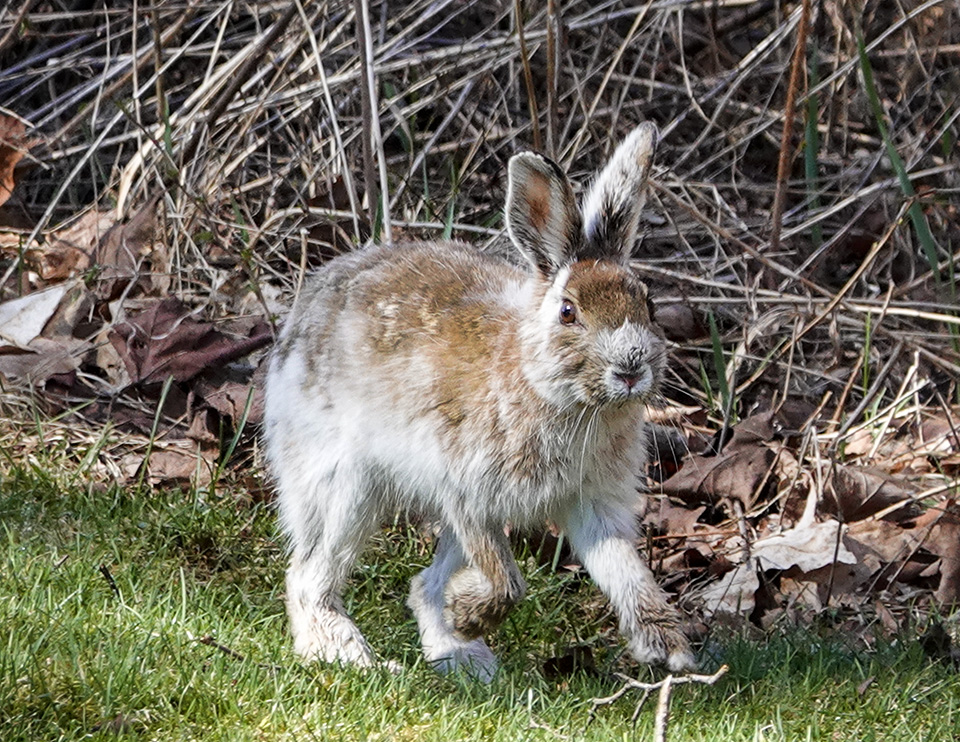
The average number and size of Snowshoe Hare litters varies, depending on the region. Across their range, Snowshoe Hares begin breeding in late winter (January - April) and end in late summer to early fall (July - October). Females can have up to four litters.
Snowshoe Hares in the Adirondacks are said to have the lowest reproductive rate for their species, with females producing six or seven young per year, in three litters of two to three young per litter. In our region, the young hares (which are called leverets) are born in May, June, and July, after a gestation of about 36 to 37 days.
Young Snowshoe Hares are precocialPrecocial: Refers to a young bird or other animal that is hatched or born in an advanced state and able to feed itself almost immediately. Precocial species are those in which the young are relatively mature and mobile from the moment of birth or hatching. The opposite developmental strategy is called "altricial", where the young are born or hatched helpless. , meaning that they are relatively independent at birth. Hares are born fully furred with their eyes open and their muscles well-developed. They can walk and hop soon after birth. Rabbits, by contrast, are altricialAltricial: Refers to young that are hatched or born in an undeveloped state, requiring care and feeding by the parents. Altricial species are those species whose newly hatched or born young are relatively immobile and unable to obtain food on their own. Examples include domestic cats, dogs, and humans. , meaning they are born in a relatively helpless state and require parental care and feeding. This difference reflects the fact that rabbits give birth and rear their young in burrows, which provides some protection from predators. Hares,on the other hand, give birth in the open, in a nest that consists essentially of a shallow depression on the ground, so the newborns must be ready to fend for themselves.
Newborns nurse right after they are born. After a day or two, they scatter to different locations (but still within their mother's territory) and stay hidden for most of the day. The young gather once a day in the evening to nurse. The milk of Snowshoe Hares is highly concentrated, allowing the leverets to nurse for a short period of time, which minimizes the time the entire litter is together, thus minimizing predation risk. After suckling, the young hares and their mother separate, with the leverets returning to hiding cover in separate locations. Weaning takes place at four to six weeks, with the young dispersing by autumn.
Snowshoe Hare: Behavior
Snowshoe Hares are said to be crepuscularCrepuscular: Refers to animals that are active primarily during twilight (dusk and dawn). This activity pattern contrasts with that of animals which are diurnal (active during the day), as well as those that are nocturnal (active during the hours of darkness). (meaning they are most active at dawn and dusk) to nocturnalNocturnal: Animal behavior characterized by being active during the night and sleeping during the day. Nocturnal animals often have highly developed senses of hearing and smell, and specially adapted eyesight to help them get around in the dark. (meaning they are active at night, while sleeping during most of the day). They spend most of the day resting in shallow depressions called "forms," which are scraped out under ferns, brush, or downed timber. Activity levels display moderate seasonal differences, with activity highest in spring and summer, moderate in autumn, and lowest in winter.
Snowshoe Hares move by hopping or in a shuffling walk. They generally travel along pathways or trails. Although they usually avoid water, they are said to be good swimmers and will leap into ponds or rivers to escape a predator.
Hares communicate using a variety of visual, chemical, and mechanical signals. Vocalization includes clicking sounds, whines, grunts, and squeals. Most sounds are associated with fear or displeasure.
The Snowshoe Hare's main strategy for avoiding detection by predators is to remain motionless. If detected, they can leap into a full run, with bursts of speed up to 25-35 miles per hour in a few seconds.
Snowshoe Hare: Mortality and Predators
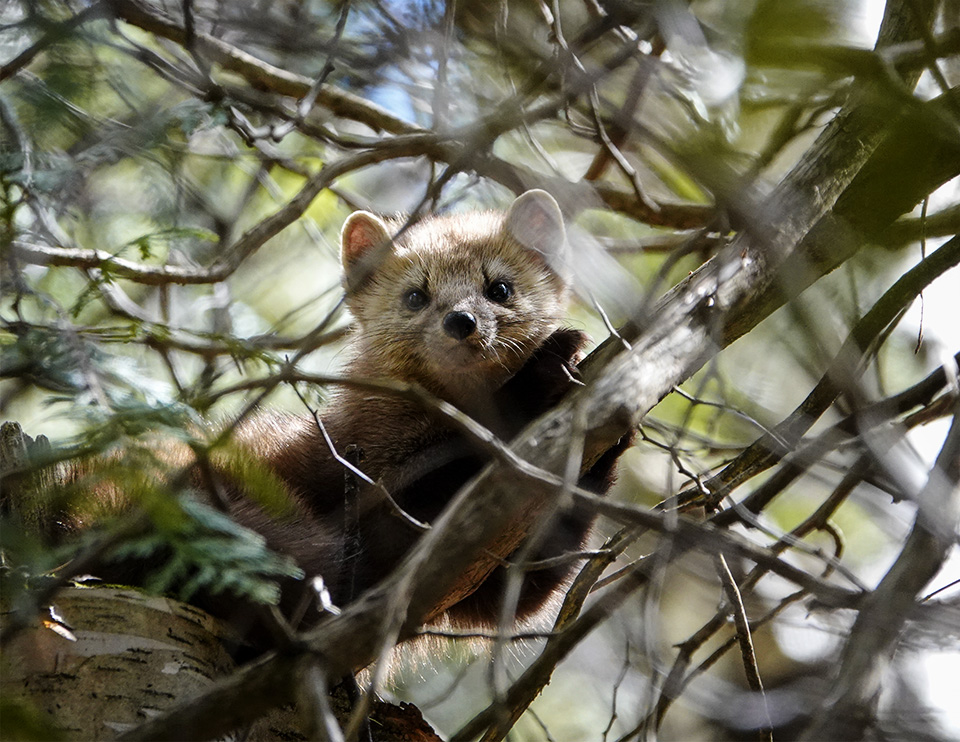
Predation is the major cause of mortality in Snowshoe Hares. Most studies indicate that losses from mammalian and avian predators are over 75%.
- The list of mammals who prey on the Snowshoe Hare in the Adirondack Park include Bobcat, Eastern Coyote, Gray Fox, Fisher, American Marten, Ermine, and Long-tailed Weasel. In other parts of their range, the Snowshoe Hare is also the principal food source for the Canada Lynx, which have been extirpated in the Adirondacks.
- Avian predators include Great Grey Owl, Snowy Owl, Northern Goshawk, Red-tailed Hawk.
Mortality from other causes, including disease, starvation, and automobiles, is much lower. In our part of New York State, Snowshoe Hares may be hunted from 1 October to 15 March, with a daily bag limit of six. However, hunting does not appear to be a major cause of mortality, probably because the Snowshoe's nonhuman predators take such a major toll.
In many parts of its range, Snowshoe Hare populations fluctuate dramatically, with periodic declines in cycles of eight to eleven years. Various hypotheses have been advanced to explain this cycle, many focusing on the relationship between hare population and predation.
The dramatic cyclic fluctuations observed in Alaska and much of Canada have not been seen in Snowshoe Hare populations in the southern parts of their range, including in the Adirondacks. Researchers have proposed several hypotheses to explain this absence of population cycles. One explanation is that predators in the southern parts of the Snowshoe Hare's range can rely on alternate prey, and so their populations do not respond numerically to hare population declines as seen in higher latitudes.
The longterm population trend for Snowshoe Hares in northern New York is a general decline.
- Snowshoe Hare densities reportedly were high during the 1950s and 1960s, but have since leveled off.
- This trend may be related to climate change, which has altered the timing and duration of snow pack. The Snowshoe Hare's white coat in winter and mottled brown coat in summer helps them hide from predators. The duration of snow cover, however, has decreased due to climate change, resulting in an increasing number of days when there is a mismatch between the hares and their surroundings, impeding the hare's effectiveness at evading predation and leading to higher predation rates.
- Declining Snowshoe Hare populations, in turn, have direct implications for the animals that prey on them, such as Fishers.
Snowshoe Hare: Distribution
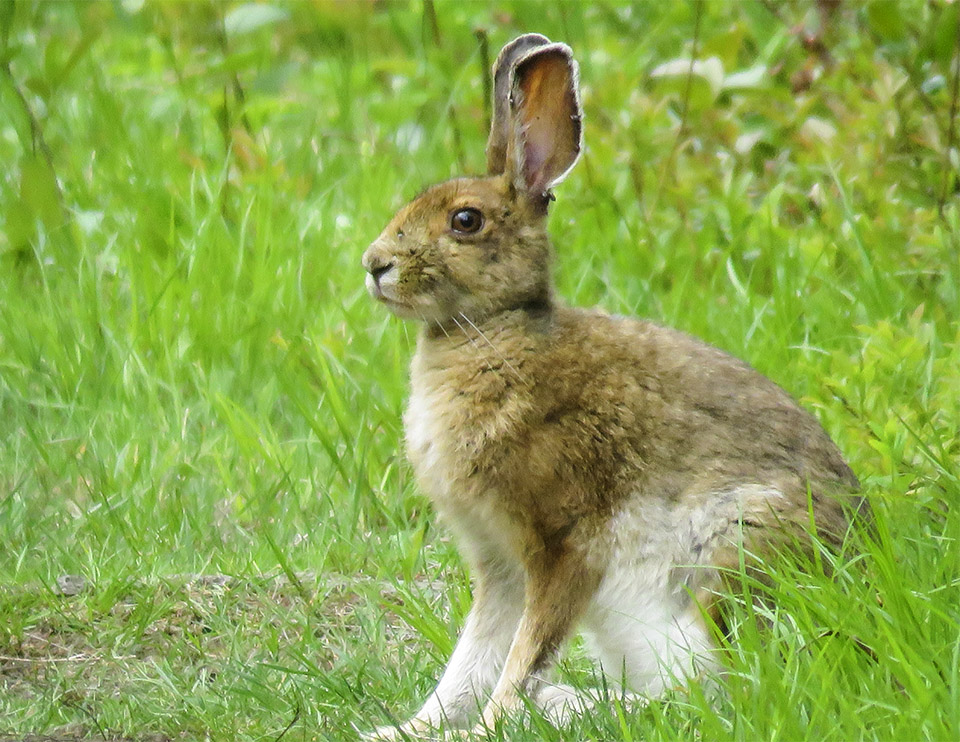
The Snowshoe Hare is found from the tree line of the North American continent south into the northern United States and the Northeast. This species occurs from Newfoundland east to western Alaska; south in the Sierra Nevada to central California; and in the Rocky Mountains to southern Utah and northern New Mexico. Snowshoes are also found in the Appalachian Mountains south to North Carolina and Tennessee.
In New York State, Snowshoe Hares are largely confined to the Adirondack Mountains. The Snowshoe is the only member of the Leporidae family found throughout much of the Adirondack Park. This pattern is reflected in the map of iNaturalist observations of Snowshoe Hares for New York State, which shows observations limited almost completely to areas within the Adirondack Park Blue Line, particularly the central and northern parts of the Adirondacks, with a few observations in the Catskills and a few others just outside the Blue Line. By contrast, observations of Eastern Cottontails in New York State are much more numerous than those of Snowshoe Hares and located almost exclusively outside Park boundaries.
Snowshoe Hare Habitat
Snowshoe Hares are found in conifer and mixed wood forests with abundant understories. The hare's habitat preferences reflect two factors: predation risks and browse needs.
- Snowshoe Hares prefer conifer stands where the trees are tall enough to provide protection from avian predators such as owls, but dense enough to offer protection from terrestrial predators such as Eastern Coyotes. The dense stands of conifers (8-16 feet high) provide a place for Snowshoe Hares to rest during the day and thermal cover in cold weather. Hares also need conifers to provide travel corridors between resting and feeding areas.
- Snowshoe Hares also need woody browse which is critical during winter months.
The presence of cover is the main determinant of habitat quality and appears to be more important in the Snowshoe's choice of habitat than food availability. Snowshoe Hares prefer relatively young forests, which tend to have abundant understories. They generally avoid non-forested areas and more mature forests that have little undergrowth.
Where to See Snowshoe Hares in the Adirondacks
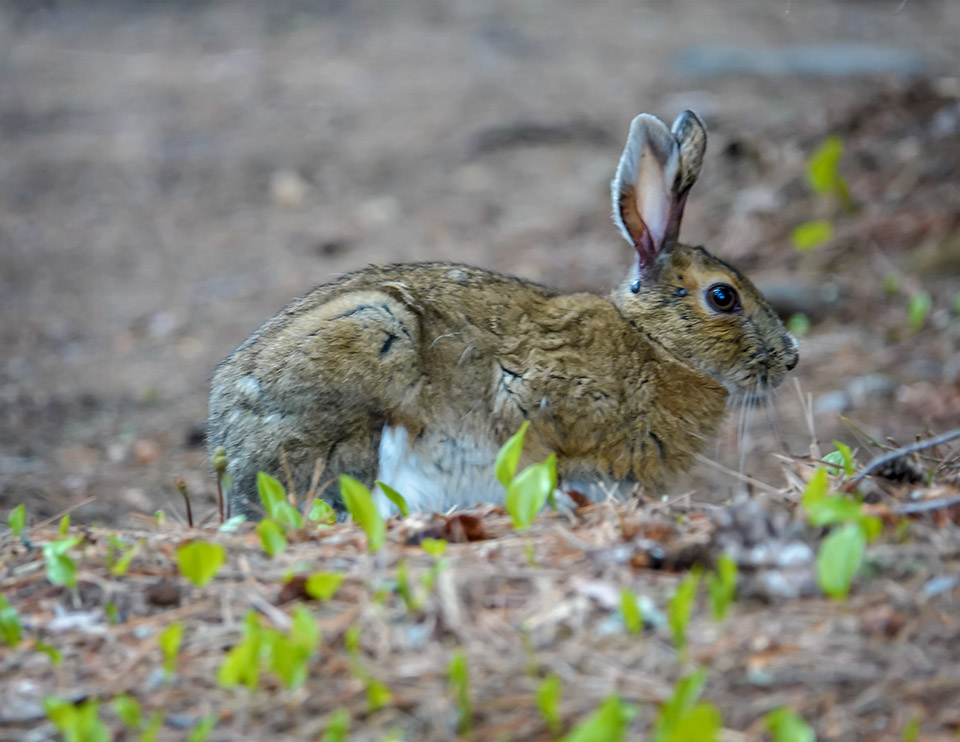
Snowshoe Hares are not commonly seen for much of the year, due to their largely nocturnal habits and preference for dense forest cover. The most likely time to see them is in the spring, when they venture into open areas to forage on dense spring growth. Also, the patchy remnants of their white winter coat make them more easily seen at this time. You might catch a glimpse of them on grassy trails or in grassy open areas, where they tend to stay fairly close to the woodland edges. The best time to see them is early in the morning or towards evening.
The presence of Snowshoe Hares can also be deduced from the signs they leave behind.
- During the winter, the most common sign is their tracks in the snow. Look for round front tracks about 1¾ inches long and triangular hind tracks up to five inches long.
- Another sign to look for in all seasons is Snowshoe Hare scat. In areas where Snowshoe Hares are abundant, such as near the camping areas along the Heart Lake Trail, Snowshoe Hare scat (slightly flattened, brown spheres about ½ inch in diameter) is commonly seen.
- Another mark of Snowshoe Hare presence is the pattern of tooth marks on twigs of shrubs and sapling trees. Hares cut off twigs leaving a neat, 45 degree angle cut, usually about a foot or so from the ground.
- Another sign to look for is the network of runways that Snowshoe Hares use to get from one feeding or resting place to another. The runways are about four to six inches wide and are usually found in brushy areas.
Adirondack Mammal List
References
New York State Department of Environmental Conservation. New York Furbearer Update. Fall 2018. Retrieved 9 November 2019.
New York State Department of Environmental Conservation. Snowshoe Hare Hunting Opportunities. Retrieved 16 November 2019.
New York State Department of Environmental Conservation. Varying Hare Hunting Seasons. Retrieved 9 November 2019.
State University of New York. College of Environmental Science and Forestry. Snowshoe Hare. Retrieved 29 March 2017.
United States Environmental Protection Agency. Wildlife Exposure Factors Handbook. Office of Research and Development. EPA/600/R-93/187 (December 1993). pp. 80, 354. Retrieved 17 January 2019.
E. Ellsworth and T.D. Reynolds. (19 July 2006). Snowshoe Hare (Lepus americanus): A Technical Conservation Assessment. USDA Forest Service, Rocky Mountain Region. 19 July 2006. Retrieved 17January 2019.
Janet Sullivan, "Lepus americanus," in Fire Effects Information System (FEIS). Species Reviews. Forest Service, Rocky Mountain Research Station, Fire Sciences Laboratory (United States Department of Agriculture, 1995). Retrieved 20 January 2019.
Integrated Taxonomic Information System On-line Database. Lepus americanus. Retrieved 9 November 2019.
IUCN Red List of Threatened Species. Snowshoe Hare. Lepus americanus. Retrieved 10 November 2019.
D. Andrew Saunders. Adirondack Mammals (Adirondack Wildlife Program. State University of New York. College of Environmental Science and Forestry, 1988), pp. 68-75, 147-151,169-185, 198-201.
William K. Chapman. Mammals of the Adirondacks. A Field Guide (North Country Books, 1991), pp. 48-52, Plate 10.
New York State. Department of Environmental Conservation. New York Natural Heritage Program. Ecological Communities of New York State. Second Edition (March 2014), p. 102. Retrieved 17 October 2015.
New York Natural Heritage Program. 2019. Online Conservation Guide for Boreal Heath Barrens. Retrieved 10 November 2019.
iNaturalist. Adirondack Park Sightings. Snowshoe Hare. Lepus americanus. Retrieved 18 April 2021.
Alexander C. Martin, Herbert S. Zim, and Arnold L. Nelson. American Wildlife & Plants. A Guide to Wildlife Food Habits (Dover Publications, 1951), pp. 238-239, 287-294, 300-306, 308-310, 323-327, 329-331, 334-335, 339-340, 364-365, 369, 385-386, 398-399, 402-403, 411-412, 425-426. Retrieved 18 April 2021.
John Eastman. The Book of Swamp and Bog: Trees, Shrubs, and Wildflowers of Eastern Freshwater Wetlands (Stackpole Books, 1995), pp. 5, 49. 108, 120, 147, 177, 192, 232.
John Eastman. The Book of Forest and Thicket: Trees, Shrubs, and Wildflowers of Eastern North America (Stackpole Books, 1992), pp. 7, 28, 100, 135, 155, 183.
John Eastman. The Book of Field and Roadside: Open-Country Weeds, Trees, and Wildflowers of Eastern North America (Stackpole Books, 2003), pp. 114, 139, 228, 279.
James M. Ryan. Adirondack Wildlife. A Field Guide (University of New Hampshire Press, 2008), pp. 185-187.
Donald W. Stokes and Lillian Q. Stokes. A Guide to Animal Tracking and Behavior (Little, Brown and Company, 1986), pp. 18-19, 56-57, 74, 80, 104, 106, 170-177.
E. Robert Hall and Keith R. Kelson. The Mammals of North America (The Ronald Press Company, 1959), pp. 272-295. Retrieved 9 November 2019.
William Henry Burt. A Field Guide to the Mammals of North America North of Mexico. Third Edition (Houghton Mifflin Company, 1980), p. 104, Plate 20. Retrieved 12 February 2019.
Luigi Boitani and Stefania Bartoli. Simon & Schuster's Guide to Mammals (Simon & Schuster, 1982), pp. 134-135. Retrieved 10 November 2019.
National Geographic Society. Wild Animals of North America (National Geographic Society, 1995), p. 91. Retrieved 12 February 2019.
Adrian Forsyth. Mammals of North America. Temperate and Arctic Regions. (Firefly Books, 1999), pp. 63, 66-69, 73-74.
Richard M. DeGraaf and Mariko Yamasaki. New England Wildlife: Habitat, Natural History, and Distribution (University Press of New England, 2001), pp. 320-321, 340-344, 347-350, 356-357, 418, 450. Retrieved 12 February 2019.
Dennis L. Murray, "Snowshoe Hare and Other Hares," in George A. Feldhamer, Bruce C. Thompson, and Joseph A. Chapman (Eds). Wild Mammals of North America: Biology, Management, and Conservation. Second Edition (The Johns Hopkins University Press, 2003) pp. 147-175.
Clinton Hart Merriam. The Mammals of the Adirondack Region, Northeastern New York (Self-published, 1884), pp. 305-311. Retrieved 2 March 2017.
Cornell Lab of Ornithology, Ithaca, New York. Birds of North America. Subscription Web Site. Great Grey Owl, Snowy Owl, Northern Goshawk, Red-tailed Hawk. Retrieved 11 November 2019.
State University of New York. Snowshoe Hare Population Status. Retrieved 11 November 2019.
Can Camouflage Keep up with Climate Change? Connecting Climate Projections to Adaptation for the Snowshoe Hare. Project Explorer. Climate Adaptation Science Centers. Retrieved 19 January 2019.
L. Scott Mill, Marketa Zimova, Jared Oyler, Steven Running, John T. Abatzoglou, and Paul M. Lukacs," Camouflage Mismatch in Seasonal Coat Color Due to Decreased Snow Duration," Proceedings of the National Academy of Sciences of the United States of America, July 9, 2013, Volume 10, Number 28. Retrieved 19 January 2019.
Marketa Zimova, L. Scott Mills, Paul M. Lukacs, and Michael S. Mitchell, " Snowshoe Hares Display Limited Phenotypic Plasticity to Mismatch in Seasonal Camouflage," Proceedings of the Royal Society B: Biological Sciences, Volume 281 (2014). Retrieved 19 January 2019.
Shawn Cleveland and H. Brian Underwood, "Chasing Snow: The Behavioral Consequences of Inconsistent Snow on a Snow Specialist," American Fisheries Society & the Wildlife Society 2019 Joint Annual Conference. 2 October 2019. Abstract. Retrieved 12 November 2019.
Evan Wilson and Jonathan Pauli, "Reenacting the Range Contraction of Snowshoe Hare Via an Experimental Translocation," American Fisheries Society & the Wildlife Society 2019 Joint Annual Conference. 2 October 2019. Abstract. Retrieved 12 November 2019.
Joseph Dell, "The Varying Hare," New York State Conservationist, Volume 31, Number 3 (November-December 1976), pp. 3, 44. Retrieved 14 February 2019.
Rainer H. Brocke, "Preliminary Guidelines for Managing Snowshoe Hare Habitat in the Adirondacks," Transactions of the Northeast Section of The Wildlife Society, Volume 32, 1975, pp. 46-66. Retrieved 14 February 2019.
Rainer H. Brocke, "Mechanics of Replenishment of a Heavily Hunted Population of Snowshoe Hares," Adirondack Wildlife Research Project Reports Funded by the Pittman-Robertson Act. 10 (1977). Retrieved 9 November 2019.
Jeanna S. Fox and Rainer H. Brocke, "The Role of Parasites and Diseases in the Diseases in the Distribution and Abundance of Bobcats in New York," Adirondack Wildlife Research Project Reports Funded by the Pittman-Robertson Act. 19 (1983). Retrieved 9 November 2019.
Lloyd B. Fox and Rainer H. Brocke, "Biology, Ecology and Range of the Bobcat, Lynx Rufus in New York and its Inferred Interactions with Potentially Reintroduced Lynx, Lynx canadensis canadensis in Adirondack Park," Adirondack Wildlife Research Project Reports Funded by the Pittman-Robertson Act. Paper 17 (1983). Retrieved 9 November 2019.
Rainer H. Brocke, "Restoration of the Lynx Lynx Canadensis in Adirondack Park: A Problem Analysis and Recommendations," Adirondack Wildlife Research Project Reports Funded by the Pittman-Robertson Act. 18. (1983). Retrieved 9 November 2019.
Rainer H. Brocke, "Observing Snowshoe Hares in Adirondack Forest Openings and Management Implications," Adirondack Wildlife Research Project Reports Funded by the Pittman-Robertson Act. Paper 16. (1980) Retrieved 9 November 2019.
Joye Harold Severaid, "Breeding Potential and Artificial Propagation of the Snowshoe Hare," The Journal of Wildlife Management, Volume 9, Number 4 (October 1945), pp. 290-295, Retrieved 3 November 2019.
Joye Harold Severaid, "Pelage Changes in the Snowshoe Hare. (Lepus americanus struthopus Bangs," Journal of Mammalogy, Volume 26, Number 1 (February 1945), pp. 41-63. Retrieved 2 November 2019.
Lauritis W. Krefting, The Effect of White-tailed Deer and Snowshoe Hare Browsing on Trees and Shrubs in Northern Minnesota. Agricultural Experiment Station. University of Minnesota. Technical Bulletin 302-1975. Forestry Series 18. Retrieved 18 January 2019.
Michael J. Conroy, Leslie W. Gysel and Glenn R. Dudderar, "Habitat Components of Clear-Cut Areas for Snowshoe Hares in Michigan," The Journal of Wildlife Management, Volume 43, Number 3 (July 1979), pp. 680-690. Retrieved 10 February 2019.
Celia Evans, Jorie Favreau, Mara Moser, and Michael Brennan," Snowshoe Hare Browse Behavior in the Adirondacks: How Availability, Preference, and Forest Structure Influence Winter Browse Choices," 95th Ecological Society of America. Annual Convention 2010. Abstract. Retrieved 12 November 2019.
Jorie Favreau, Celia Evans and Jessie Gardner, "Snowshoe Hare Movement Behavior in the Adirondacks: The Effects of Available Food and Cover on Home Ranges and Moves," 95th Ecological Society of America. Annual Convention 2010. Abstract. Retrieved 12 November 2019.
Celia Evans, "Snowshoe Hares in Winter," Outside Story, 26 January 2015. Retrieved 16 November 2019.
A.W. Bromley, "Re Adirondack Coyotes," New York State Conservationist, Volume 10, Number 4 (February-March 1956), pp. 8-9. Retrieved 9 November 2019.
Robert E. Chambers, Peter Gaskin, Roger A. Post, and Stuart Cameron, "The Coyote," New York State Conservationist, Volume 29, Number 2 (October-November 1974), pp. 5-7. Retrieved 9 November 2019.
New York State Department of Environmental Conservation. The Status and Impact of Eastern Coyotes in Northern New York (Bureau of Wildlife, June 1991). Retrieved 19 March 2017.
Scott A. Warsen. Evolving Niche Of Coyotes In The Adirondack Mountains of New York: Long-Term Dietary Trends and Interspecific Competition. A thesis submitted in partial fulfillment of the requirements for the Master of Science Degree State University of New York, College of Environmental Science and Forestry (Syracuse, New York. May 2012). Retrieved 18 January 2019.
Jacqueline Frair and Mark Teece. Evolving Niche of the "Coy-wolf" in Northeastern Forests and Implications for Biodiversity. Undated. Retrieved 19 January 2019.
Jacqueline Frair, James Gibbs, Gordon Batcheller, and Paul Jensen. Population Status and Foraging Ecology of Eastern Coyotes in New York State (2014). Retrieved 10 January 2019.
Robert E. Chambers, "Diets of Adirondack Coyotes and Red Foxes," Transactions of the Northeast Section, the Wildlife Society, Volume 44 (1987), p. 90.
William Hamilton, "Food Habits of the Coyote in the Adirondacks," New York Fish and Game Journal, Volume 21, Number 2 (July 1974), pp. 177-181. Retrieved 9 November.
Matthew E. Gompper. The Ecology of Northeast Coyotes: Current Knowledge and Priorities for Future Research. WCS Working Paper Number 17 (July 2002). Retrieved 10 February 2019.
John A. Litvaitis, James A. Sherburne and John A. Bissonette, "Bobcat Habitat Use and Home Range Size in Relation to Prey Density," The Journal of Wildlife Management, Volume 50, Number 1 (January 1986), pp. 110-117. Retrieved 23 February 2019.
Paul G. Jensen, Charlotte L. Demers, Stacy A. Mcnulty, Walter J. Jakubas and Murray M. Humphries, "Marten and Fisher Responses to Fluctuations in Prey Populations and Mast Crops in the Northern Hardwood Forest," The Journal of Wildlife Management, Volume 76, Number 3 (April 2012), pp. 489-502. Retrieved 10 February 2019.
